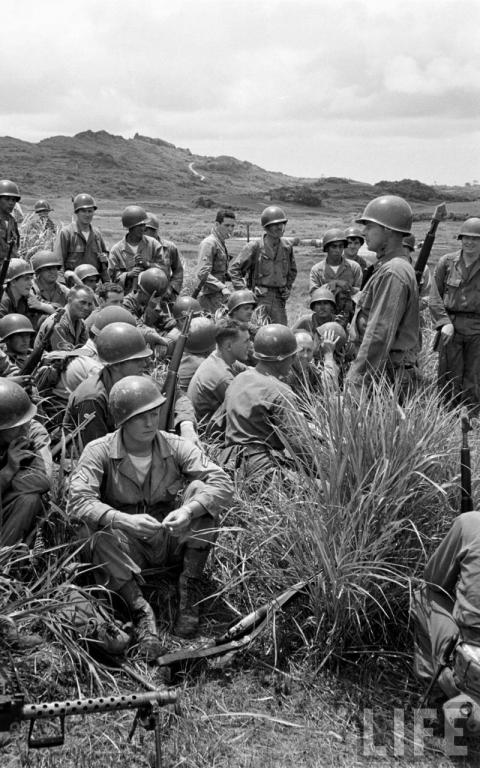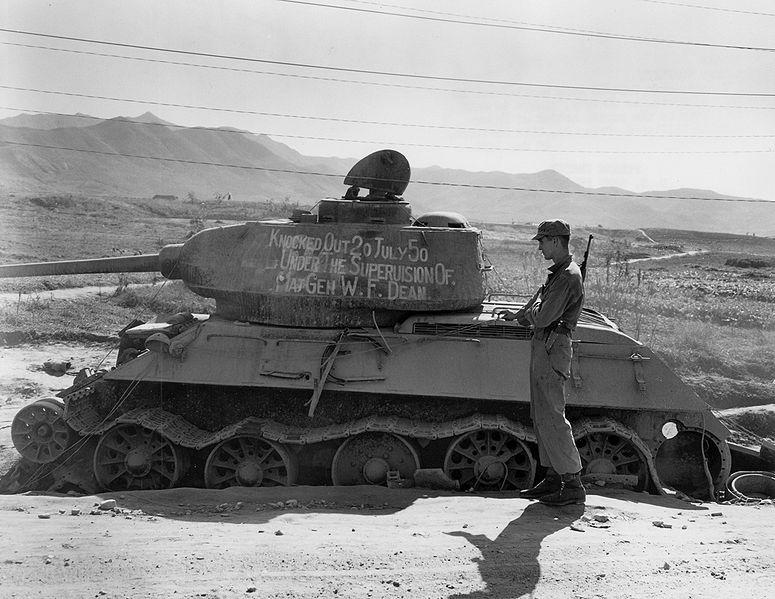Remugen Bridge Okinawa Casino & Anzio Battlefield Taejon Battle Ground
Date taken:June 1951
Photographer:Walter Sanders And Joe Scherschel And N R Farbman
The Battle of Taejon ( 14–21 July 1950) was an early battle between United Statesand North Korean forces during the Korean War. Forces of the United States Army, attempting to defend the headquarters of the 24th Infantry Division were overwhelmed by numerically superior forces of the Korean People's Army at the major city and transportation hub of Taejon. The 24th Infantry Division's regiments were already exhausted from the previous two weeks of fighting to stem the advance of the North Korean Army.
The entire division gathered to make a final stand around Taejon, holding a line along the Kum River to the east of the city. Hampered by lack of communications equipment and shortages of heavy weapons to match North Korean firepower, the American forces, outnumbered, ill-equipped and untrained, were pushed back from the river bank after several days, before fighting an intense urban battle to defend the city. After a fierce three-day struggle, the Americans withdrew.
Although they could not hold the city, the 24th Infantry Division achieved a strategic victory by delaying the North Koreans, providing time for other American divisions to establish a defensive perimeter around Pusan further south. The delay imposed at Taejon probably prevented an American rout during the subsequent Battle of the Pusan Perimeter. Also significant, the North Koreans captured Major General William F. Dean, the commander of the 24th Infantry Division, and highest ranking American prisoner during the Korean War.
A Russianmade T34/85 tank knocked out in Taejon, Korea, on 20 July stands at testimony to the heroic action of Major General William F. Dean, Commanding Officer,24th Infantry Division.(Korean War Signal Corps Collection). The mountain looks like Bingyesan of Gyeryongsan and the river looks like Gapcheon between Daejeon and Yusong.
The first two Medals of Honor for the Korean War were awarded for the battle of Taejon.For his actions on the front lines, Dean was awarded the first Medal of Honor, although he remained a prisoner of the North Koreans until the end of the war (released in September 1953). A second soldier, Sergeant George D. Libby, received the Medal of Honor posthumously, for tending to wounded soldiers during the evacuation: he repeatedly passed over shelled roads to help evacuate them. He had been killed in the process of trying to evacuate more soldiers.Additionally, a chaplain, Herman G. Felhoelter, was awarded the Distinguished Service Cross for an incident later known as the Chaplain-Medic Massacre which took place during the battle near the Kum River.
At the end of the day on July 20, Dean ordered the headquarters of the 34th Infantry to withdraw. Dean remained behind and assisted the US troops in evacuating the city until the last convoy was ready to leave Taejon. As the last convoy of troops moved out of the city and fought through a North Korean roadblock, Dean, with a small force of soldiers, followed them. At the edge of the city, the final elements of the 34th Infantry, leaving the city in 50 vehicles, were ambushed and many of their vehicles were destroyed by machine guns and mortars, forcing the Americans to retreat on foot. In the ensuing fight, Dean's jeep made a wrong turn and was separated from the rest of the American forces.
Dean's small force eventually made it out of the city past several North Korean roadblocks. Just outside the city Dean stopped his jeep to tend to several wounded US soldiers in a wrecked truck in the ditch. However, as they attempted to escape further they ran into another North Korean roadblock and were forced to continue on foot, crossing the Taejon River and climbing a nearby mountain. In the confusion, Dean was separated from the group.
While he was going after water for a wounded man, Dean fell down a steep slope and was knocked unconscious. When he regained consciousness he found he had a gashed head, a broken shoulder, and many bruises. For 36 days, Dean wandered alone in the mountains trying to reach safety, going without food and medical treatment. The 6 feet (1.8 m) tall Dean who had weighed 210 pounds (95 kg) before the war was reduced to 130 pounds (59 kg) as he wandered for the next month. On August 25, two South Koreans who pretended to be guiding him toward safety led him into a prearranged ambush of North Korean soldiers at Chinan, 35 miles (56 km) south of Taejon and 65 miles (105 km) west of Taegu. Dean attempted to fight the North Koreans with his sidearm to make them kill him, but they easily took the weakened Dean prisoner.
By July 22, with Dean still missing, Eighth Army appointed Church commander of the 24th Infantry Division and promoted him to major general.[57] Dean was widely believed to have been killed until October 1950, when US forces captured a North Korean soldier named Lee Kyu Hyun near P'yongyang. Lee had been assigned to live with Dean for a month as an interpreter. Lee was interviewed throughout late 1950 but US military leaders still generally thought Dean was dead.Information

Warning: This is a relatively older thread
This discussion is older than 360 days. Some information contained in it may no longer be current.
- Knowledge Library

- MKL Entry of the Month
- Australia
- Austro-Hungarian Empire
- Canada
- Czechoslovakia
- Denmark
- Finland
- France/Belgium
- Germany
- Italy
- Japan
- Norway
- Russia
- South America
- Sweden
- Switzerland
- Turkey
- United Kingdom
- United States
- Yugoslavia
- Is my rifle authentic or a fake?
- Jay Currah's Lee Enfield Web Site
- On-line Service Records (Canada)
- Technical Articles/Research
- Forum
- Classifieds

- What's New?
-
Photo Gallery

- Photo Gallery Options
- Photo Gallery Home
- Search Photo Gallery List
-
Photo Gallery Search
- Video Club

- iTrader













 PM
PM
